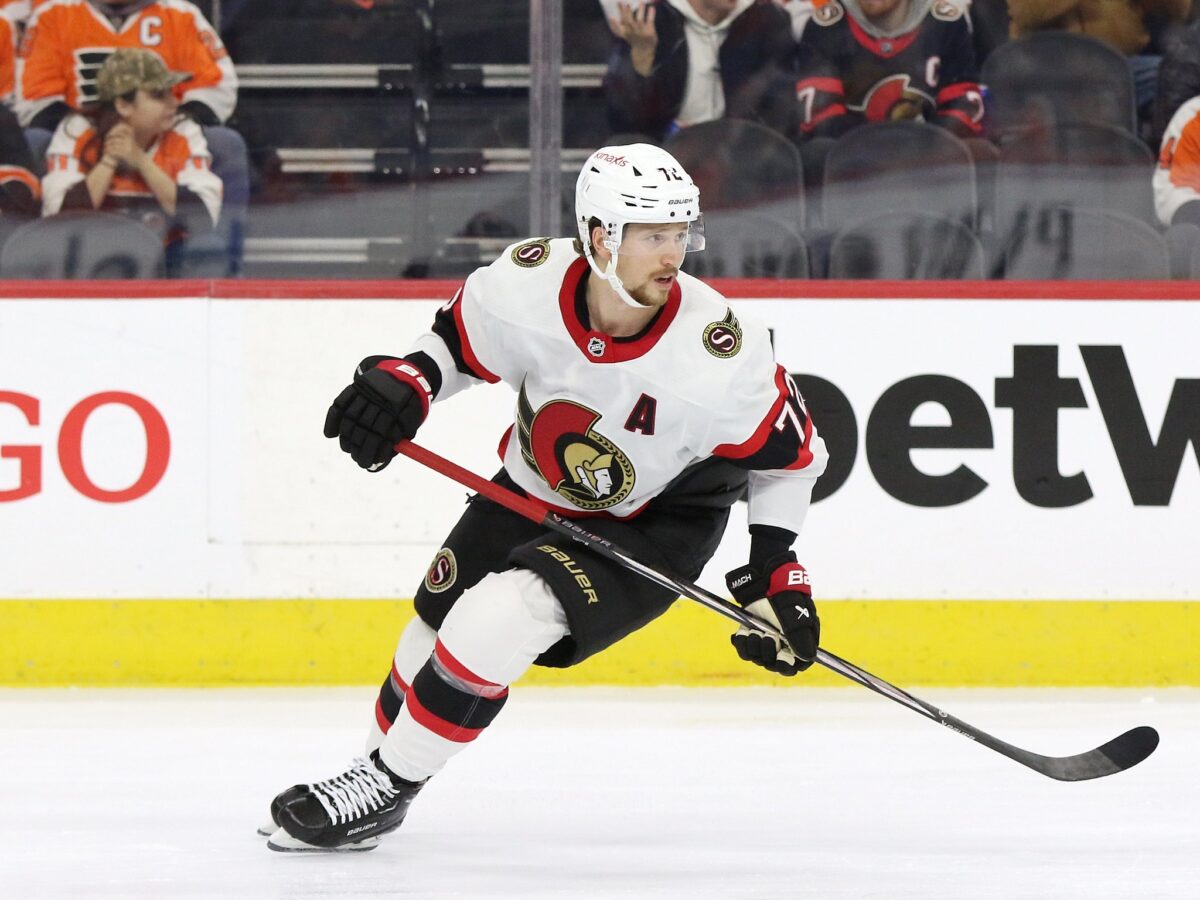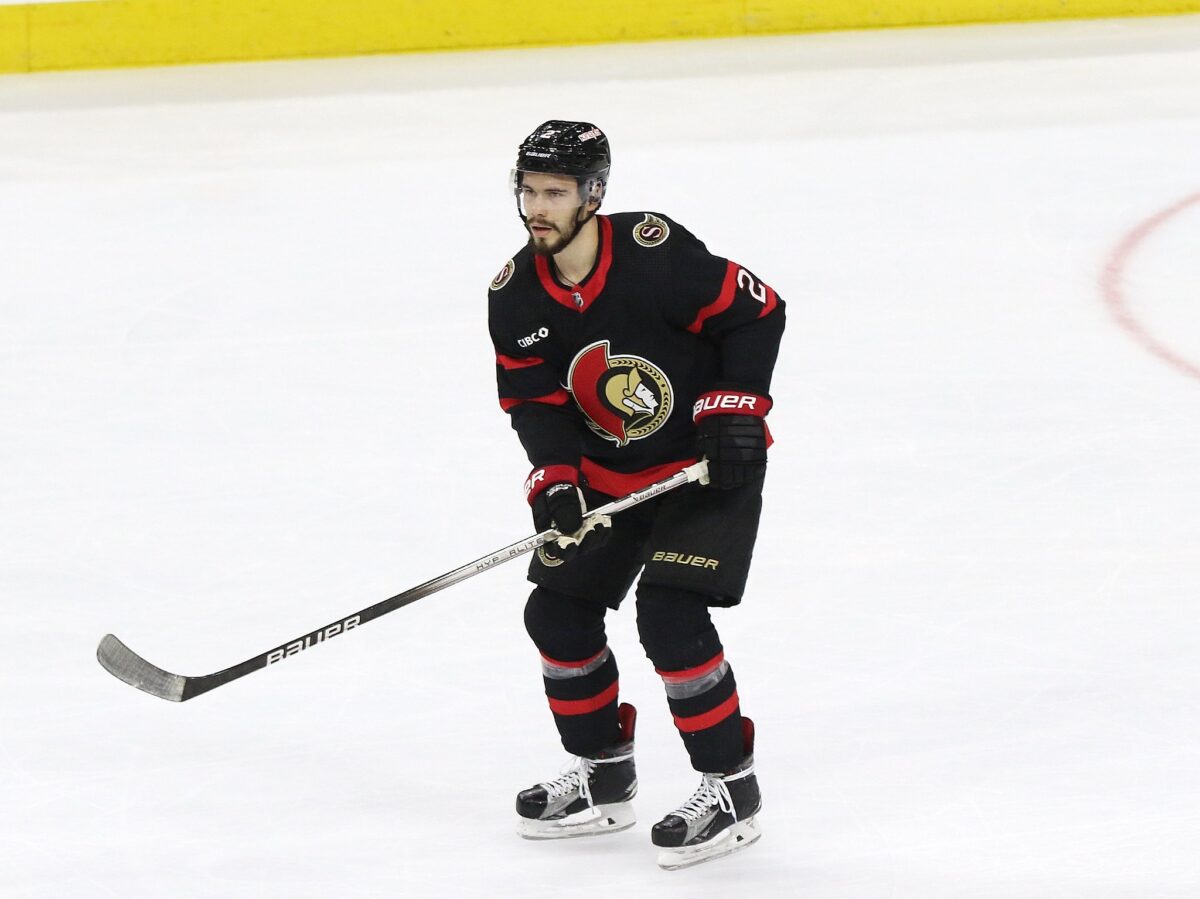Now that we have looked at the depth chart for the left-wing, right-wing, and center positions for the Ottawa Senators, it is time to move to the back end and look at the defense. Now that the draft, the first wave of free agency, and the development camp are over, the depth chart is taking shape and we have an idea of what the roster will look like.
In this fourth piece of a five-part series, we will have a look at the defensive depth the Senators have, followed by the goaltending tomorrow. When looking at the depth, the players aren’t necessarily listed as they will be in the full lineup, rather just a list starting with the best and working down towards prospects and American Hockey League (AHL) players who could be called up and given a chance. Not every AHL player will be listed, but the ones with a legitimate shot of playing even a few games in 2024-25 are.
Left Defense Depth Chart
The left side of the defense, even after moving on from Erik Brannstrom and Jakob Chychrun, is still much stronger than the right. Having two high-end top-four defensemen and a third spot for a younger player creates a good balance in the group.
Jake Sanderson
The top defenseman on the Senators is Jake Sanderson. At just 22 years old, Sanderson has already established himself as a top two-way defenseman and earned himself a $64.4 million contract. Not only has the young defenseman been a cornerstone in terms of defensive play, but his 70 points in 156 career NHL games is quietly impressive too.
Even with his strong first two seasons, there is lots of reason to believe there is still another step for him to take. He reads defensive plays well, his skating is outstanding, and he has shown that he can play a physical game at times too. This should be the year that Sanderson emerges as one of the top defensemen in the NHL. He likely won’t be in the conversation for the top 10 defensemen, but he could earn himself a spot in the top 15 or 20.
Thomas Chabot
If Thomas Chabot can stay healthy and have his ice time managed better, there is a good chance that he can return to the high-end offensive defenseman he once showed so much potential to be. Chabot’s offensive game is the highlight of his play. With 30 points in 51 games last season, his pace was good, but he has shown he can be better. The key for Chabot is to stay in the lineup. His career-high in games played is only 71, and he hasn’t hit 70 since the 2019-20 season.

His defensive game can be problematic, but when he is producing at the top of his game, it makes any defensive errors more forgivable. Now that he will have a full-time high-quality right-sided partner, which we will get to, Chabot’s game should be more balanced, and now that Sanderson has emerged as a high-end option, he should be playing much less hockey than his career average of nearly 24 minutes per game.
Tyler Kleven
Now that Brannstrom and Chychrun are gone, this is going to be Tyler Kleven’s opportunity to grasp a full-time NHL job. After being drafted in 2020, Kleven has shown that he is a physical force to be reckoned with. In the NCAA, Kleven often found himself being penalized for big, clean hits. Once he transitioned to the AHL, his penalty minutes dropped dramatically. He is able to play his physical game and match up against men much older than him with no issues.
Related: Senators’ Staios Adds Much-Needed Grit to Roster
One thing the Senators had missed at the bottom of their lineup is size. Kleven has 17 NHL games under his belt already and seemed to fit in fairly well. At his age, he may have some hiccups in the early parts of the season, but that is understandable. His game is one that should translate well to the top league, and he will add a great physical presence. In his short NHL career so far, he has shown flashes of confidence and his ability to carry the puck well. The third-pair spot on the left side is his to lose.
Jorian Donovan
The Senators’ left-handed defensive depth falls off a bit here. Not to say that Donovan isn’t a quality asset, but they don’t have any veteran options on the outside looking in. Donovan finished the season in the Ontario Hockey League (OHL) as a champion, winning the Memorial Cup. His nine points in the 17-game run were impressive, and with a defense group with other high-end defensemen like Zayne Parekh, Donovan was just as important in his role.
He isn’t likely to get any NHL games, but with an impressive training camp and a strong start to the AHL season, Donovan could certainly work his way into the conversation.
Tomas Hamara
Like Donovan, Tomas Hamara is going to need a strong start in the AHL to find himself a spot in the NHL lineup at any point this season. He is a defenseman with skill and a solid two-way game. Hamara isn’t a game-breaker but could offer a steady option in the AHL this season.
Hamara’s trade request from the Kitchener Rangers did him wonders. After scoring just three points in 18 games to start the season, Hamara was dealt to the Brantford Bulldogs where he scored 17 points in the next 26 games.
Donovan Sebrango
An asset acquired in the Alex DeBrincat trade, Donovan Sebrango had a strong first season with the Senators organization. He played in the AHL and ECHL, but in his 35 games in the AHL, he had played well defensively. He likely isn’t going to become an NHL regular, but he does have some tools that could lead to him being a bubble player who earns a call-up if necessary.
Right Defense Depth Chart
The NHL-level talent on the right side isn’t as strong as the left, but looking beyond the top three, the call-up options are arguably better and more NHL-ready than the others.
Artem Zub
Since joining the Senators as a free agent out of Russia, Zub has been the best right-handed defenseman in the organization. He has had a number of strong defensive years and has been an anchor on whatever pairing he has been placed on. Once the Senators transitioned from a chaotic DJ Smith system, Zub looked even better than before while playing under Jacques Martin.

He is the perfect defenseman to play alongside either Sanderson or Chabot because of his great shut-down play. He doesn’t have much style to his game, and without paying too much attention, you may not even notice him, but that is what makes him such a strong player. His game isn’t meant to stand out. When a player with the role of Zub is doing their job well, they don’t get noticed.
Nick Jensen
The newly-acquired Nick Jensen is bringing something the Senators have needed for a long time, and that is a partner for Chabot to play with. Jensen plays a very similar game and role as Zub but with more experience and understanding of the NHL’s pace. Zub doesn’t do much wrong in that regard, but Jensen just does it better.
Jensen does a bit of everything on the ice. He is great at blocking, can be physical, and most importantly to the Senators, doesn’t take a lot of penalties. Out of the seven defenders to play the most games last season, Chabot has the least amount of penalty minutes with 22 in 51 games. Jensen less than half of that with only 10, and played in 78 games last season. Chychrun, who was the centerpiece of the trade to bring in Jensen, led the defense with 60 penalty minutes and was fourth on the entire team. That differential in penalty minutes is critical. Chychrun’s total last season was just three penalty minutes fewer than Jensen has had over the past four seasons combined.
Jacob Bernard-Docker
After a rocky start to the 2023-24 season, including clearing waivers, Jacob Bernard-Docker had a strong bounce back from that, playing in 72 games with the Senators last season. He was one of their better options on the right side but isn’t strong enough in any aspect of his game to be a top-four defender like Zub or Jensen.
He is a fine third-pair option, or even as the seventh defenseman, but if presented with the opportunity the Senators may look to get an upgrade on him in the lineup. It was reported by Bruce Garrioch that the Senators were trying to trade Bernard-Docker, but it is evident that there wasn’t much in terms of value that the Senators would get back. (from Ottawa Sun, NO DICE: Senators continue to try to wheel and deal as draft wraps up in Vegas, June 29, 2024).
Travis Hamonic
Travis Hamonic fell out of favor in the Senators’ lineup as last season went on, and while many anticipated a buyout, general manager Steve Staios commented and said he respects the veteran presence Hamonic brings.
His play isn’t where it once was, and even since joining the Senators, has fallen off even more. He likely won’t play many games this season, and with his $1.1 million cap hit, he can still be a good role model without weighing the team down in terms of the salary cap.
Maxence Guenette
Outside of the top four right-handed defensemen who were NHL regulars last season, Maxence Guenette has the best chance to push one of them for a roster spot. Guenette actually made the team out of training camp and played seven games. He fit in well during that stint and has developed into a good defenseman.
The Senators drafted Guenette in the seventh round of the 2019 NHL Entry Draft, and since then he has shown offensive upside in the AHL, while also being able to be reliable defensively.
Nikolas Matinpalo
After the extremely successful signing of Zub, the Senators tried again last season by bringing in Nikolas Matinpalo from Finland. He only appeared in four NHL games but played 67 AHL games and was a good defender for Belleville. Matinpalo re-signed with the club this offseason, and part of that negotiation could have been to get a better chance at an NHL spot.
The depth has certainly gotten better than it has been in the last few seasons, but there is still room for improvement. The Senators could look to bring in some veterans on a tryout, like maybe Kevin Shattenkirk or Justin Schultz.
